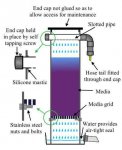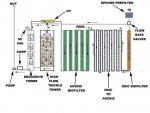Meyer Jordan
Tadpole
- Joined
- Oct 10, 2014
- Messages
- 7,177
- Reaction score
- 5,678
- Location
- Pensacola, Florida
- Hardiness Zone
- 9a
- Country

That's funny, after I posted my last comment I kept searching a bit typing nitrate and trickle tower in my search and finally came across that one article you linked to. I had no doubt that you were basing your comments on something. However, as interesting as that article is, it in no way proves that the sole purpose of a "trickle tower filter" is to remove Nitrates. Perhaps that may be the sole purpose of that very specialized nitrate reducing trickle tower design, but I don't see how why it gives this one very specialized design all inclusive rights to the term "trickle tower".
I have been around long enough to remember when this "specialized design" (as you term it) was the only design (and function) for a Trickle Tower. Everything else that you see on the web are DIY 'corruptions' of the original design and purpose.
Regardless, THIS is the configuration that is needed to reduce Nitrate levels in a pond.
Debating semantics/terminology as relates to ponds is a exercise in futility. There are those that are going to call a whale a fish no matter what!


